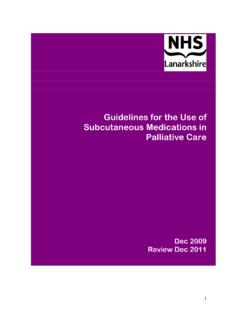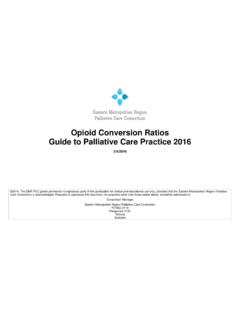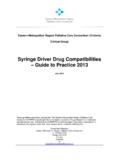Transcription of Syringe Pumps - Scottish Palliative Care Guidelines
1 Syringe Pumps Syringe Pumps Introduction Portable infusion Pumps are used in Palliative care to deliver a continuous subcutaneous infusion of medication over 24 hours. Mixing of medications in this manner is unlicensed but is supported by practice. Some acute areas will use non-ambulatory Pumps Alaris pump. Check which device is used in your area. Indications A patient is unable to take medication orally due to: Persistent nausea and/ or vomiting. Dysphagia. Bowel obstruction or malabsorption. Reduced level of consciousness, such as in the last days of life. General information Use the current local protocols for setting up and monitoring the Syringe pump you are using. The tables in this guideline contain information about preparations, dose ranges, diluents and indications for single drugs that can be given by subcutaneous infusion for symptom control in Palliative and end of life care .
2 Assessment The figures in these tables are NOT clinical doses to prescribe. Most patients will require much lower doses. Refer to relevant Guidelines to obtain usual dose range for each medication Use minimum effective dose and titrate according to response Concentrations equivalent to or less than those stated in table are physically stable for 24 hours For doses greater than those stated in the tables seek specialist advice The tables contain information about the stability and compatibilities of drug combinations for use in a subcutaneous infusion in Palliative care . The compatibility tables contain information for a subcutaneous infusion using a CME T34 Syringe pump or a non-ambulatory pump containing: o Alfentanil and one or two other drugs (see: Alfentanil guideline & seek specialist advice).
3 O Diamorphine and one or two other drugs o Hydromorphone and one or two other drugs (seek specialist advice). o Ketamine and one or two other drugs (see: Ketamine guideline & seek specialist advice). o Morphine and one or two other drugs o Oxycodone and one or two other drugs (using 10mg/ml and 50mg/ml preparations). o Drug combinations, diluents or doses other than those listed in the compatibility tables are used occasionally on the recommendation of a Palliative care specialist. Stability data to support this combination should be checked with a clinical pharmacist before infusion. Any recommendation given by the Palliative care specialist should be documented clearly in the patient's notes. Copyright 2014 NHS Scotland Page 1 of 21 Issue Date: 18/11/2014 Review Date: 14/11/2017 Syringe Pumps Single drugs used in a subcutaneous infusion over 24 hours in Palliative care Diluent: water for injection unless stated and make up to 17ml in 20ml Syringe or 22ml in 30ml Syringe using a CME T34.
4 Pump or 24ml or 48ml in a 50ml Syringe in a non-ambulatory pump. Single agents Indications and dose range Comments Opioids See Choosing & Changing opioids MORPHINE SULFATE Indications: opioid responsive pain, 1st line opioid analgesic. Caution in stage 4/5 chronic kidney disease. 10mg, 30mg in 1ml breathlessness. 60mg in 2ml (other strengths available Dose: 5 to 10mg/24 hours, if no but not used commonly) opioid before DIAMORPHINE Indications: opioid responsive pain, Can be diluted in a small volume. Preferred for high opioid doses. 5mg, 10mg, 30mg, 100mg, breathlessness. Caution in stage 4/5 chronic kidney disease. 500mg powder Dose: 5 to 10mg/24 hours, if no opioid before ampoules OXYCODONE Indications: opioid responsive pain, 2nd line opioid analgesic if morphine/. diamorphine not tolerated.
5 10mg in 1ml breathlessness. Caution in stage 4/5 chronic kidney disease 20mg in 2ml Dose: 2 to 5mg/ 24 hours, if no opioid before 50mg in 1ml (use may be restricted in some areas). ALFENTANIL Indications: opioid responsive pain, 3rd line opioid; specialist advice needed. 1st line in stages 4/5 chronic kidney disease. 1mg in 2ml breathlessness. Caution with high strength preparation (5mg in 1ml); only use in line with local policy. 5mg in 1ml (use may be restricted in Dose: Specialist advice and some areas) supervision required. HYDROMORPHONE Indications: opioid responsive pain, 3rd line opioid; specialist advice needed. breathlessness. Unlicensed preparation available from Cardinal 10mg in 1ml Health Martindale Products Dose: Specialist advice and Caution in stage 4/5 chronic kidney disease 20mg in 1ml supervision required.
6 50mg in 1ml Copyright 2014 NHS Scotland Page 2 of 21 Issue Date: 18/11/2014 Review Date: 14/11/2017 Syringe Pumps Single drugs used in a subcutaneous infusion over 24 hours in Palliative care Diluent: water for injection unless stated and make up to 17ml in 20ml Syringe or 22ml in 30ml Syringe using a CME T34. pump or 24ml or 48ml in a 50ml Syringe in a non-ambulatory pump. Single agents Indications and dose range Comments Antiemetics CYCLIZINE Indications: nausea and vomiting Anticholinergic; reduces peristalsis. (bowel obstruction or intracranial Can cause redness, irritation at site. 50mg in 1ml disease). Incompatible with saline Dose: 50 to 150mg / 24 hours METOCLOPRAMIDE Indications: nausea and vomiting Prokinetic. Avoid if complete bowel obstruction or colic. 10mg in 2ml (peristaltic failure, gastric stasis/outlet Possible risk of extrapyramidal side effects obstruction, opioid).
7 Dose: 20 to 120mg / 24 hours HALOPERIDOL Indications: opioid or metabolic Long half-life: can also be given as a once daily SC. induced nausea, delirium. injection. 5mg in 1ml Extrapyramidal side effects Dose: 2 to 5mg / 24 hours 10mg in 2ml LEVOMEPROMAZINE Indications: complex nausea, terminal Protect from light, exposure can cause delirium/ agitation. purple/yellow discolouration; discard if this occurs. 25mg in 1ml Lowers blood pressure. Dose: 5 to 25mg / 24 hours - Long half-life: can be given as a once or twice antiemetic. daily SC injection. Second line sedative if midazolam ineffective. Dose: 25 to 100mg / 24 hours - See: Levomepromazine guideline. sedative. Copyright 2014 NHS Scotland Page 3 of 21 Issue Date: 18/11/2014 Review Date: 14/11/2017 Syringe Pumps Single drugs used in a subcutaneous infusion over 24 hours in Palliative care Diluent: water for injection unless stated and make up to 17ml in 20ml Syringe or 22ml in 30ml Syringe using a CME T34.
8 Pump or 24ml or 48ml in a 50ml Syringe in a non-ambulatory pump. Single agents Indications and dose range Comments Anticholinergics for chest secretions or bowel colic HYOSCINE BUTYLBROMIDE Indications: chest secretions, bowel 1st line; non-sedative obstruction (colic, vomiting). (Buscopan). Dose: 40 to 120mg / 24 hours 20mg in 1ml GLYCOPYRRONIUM Indications: chest secretions or colic. 2nd line; non-sedative. Longer duration of action than hyoscine. 200 micrograms in 1ml Dose: 600 to 1200 micrograms /24. hours 600 micrograms in 3ml HYOSCINE HYDROBROMIDE Indications: chest secretions. 3rd line; sedative. Can precipitate delirium 400 micrograms in 1ml Dose: 400 to 1200 micrograms / 24. hours 600 micrograms in 1ml Single drugs used in a subcutaneous infusion over 24 hours in Palliative care Diluent: water for injection unless stated and make up to 17ml in 20ml Syringe or 22ml in 30ml Syringe using a CME T34.
9 Pump or 24ml or 48ml in a 50ml Syringe in a non-ambulatory pump. Single agents Indications and dose range Comments Non Steroidals (NSAIDS). DICLOFENAC Indications: relief of pain and Administer in separate Syringe pump, inflammation. incompatible with most drugs 75mg in 3ml Avoid in patients with history of, or risk factors for Dose: 75 to 150mg/ 24 hours heart disease. Monitor renal function Injection is irritant, dilute maximally with saline KETOROLAC Indications: short term management Likely to cause more GI irritation than diclofenac, of pain concurrent gastro protection recommended. 10mg in 1ml Avoid in patients with history of, or risk factors for Dose:60 to 90mg/ 24 hours heart disease. 30mg in 1ml Monitor renal function Injection is irritant, dilute maximally with saline. Copyright 2014 NHS Scotland Page 4 of 21 Issue Date: 18/11/2014 Review Date: 14/11/2017 Syringe Pumps Single drugs used in a subcutaneous infusion over 24 hours in Palliative care Diluent: water for injection unless stated and make up to 17ml in 20ml Syringe or 22ml in 30ml Syringe using a CME T34.
10 Pump or 24ml or 48ml in a 50ml Syringe in a non-ambulatory pump. Single agents Indications and dose range Comments Sedative MIDAZOLAM Indications: myoclonus, seizures, Anxiolytic (5 to 10mg/ 24 hours). terminal delirium/ agitation. Muscle relaxant (5 to 20mg/ 24 hours). 10mg in 2ml Anticonvulsant (20 to 30mg/ 24 hours). Dose: titrate dose according to 1st line sedative (20 to 80mg / 24 hours). symptoms and response. 10mg in 2ml preparation for Palliative care . Single drugs used in a subcutaneous infusion over 24 hours in Palliative care Diluent: water for injection unless stated and make up to 17ml in 20ml Syringe or 22ml in 30ml Syringe using a CME T34. pump or 24ml or 48ml in a 50ml Syringe in a non-ambulatory pump. Single agents Indications and dose range Comments Other medication occasionally given by the subcutaneous (SC) route in Palliative care DEXAMETHASONE INJECTION Indications: bowel obstruction, raised Check preparation: available as different dose or intracranial pressure or intractable formulations.







![[P] Clonazepam - Palliative Care](/cache/preview/7/3/1/8/c/1/0/f/thumb-7318c10f561f7c7ba618d52f79801a4d.jpg)

